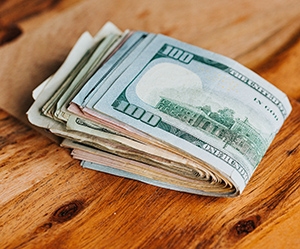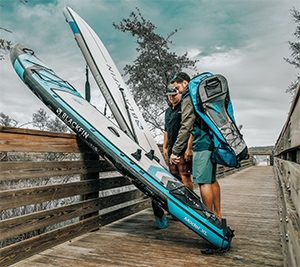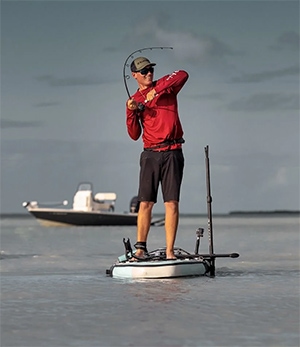More and more people are taking up paddle boarding. You’ve decided that you don’t want to be left out. But when you start looking around for a good paddle board, you can’t believe the price tags. How can something so simple cost that much?
I recommend spending at least $500 for a decent inflatable paddle board and $700 for a rigid (solid) paddle board. That may sound like a lot!
So why are paddle boards so expensive?
Paddle boards incorporate advanced technology and costly materials. This makes them expensive. There’s also a big demand for paddle boards at the moment, which has pushed prices up.
Read on to find out more!
RELATED: Discover the best inflatable sup boards of 2024.
How Much Do Paddle Boards Cost: Are They Really Expensive?

There’s no straightforward answer to this question because it depends on the board you’re looking at.
The truth is that you can get a SUP with whatever cash you have.
Stand up paddle boards cost anywhere from $200 to $3000. The super cheap ones are mainly inflatable paddle boards.
However, if you pay $200, you can’t expect much from the paddle board in terms of performance. I recommend spending at least $500 for an inflatable and $700 for a solid paddle board to get a decent all-around paddle board.
So, why do paddle boards cost so much? Let’s find out.
Why Are Stand Up Paddle Boards So Expensive?
There are a number of factors driving the price of paddle boards at any point in time. Here are the main ones:
1. Supply and Demand: The Popularity of the Sport

Stand up paddle boarding has been growing steadily in popularity over the past few years. Everyone seems to be doing it, including a number of A-list celebrities.
Social platforms are filled with photos and videos of people enjoying the sport.
Add to this the claims about the health benefits of paddle boarding. They’re not empty claims anymore because there are scientific studies to back them up.
Google searches relating to SUP have been increasing too. This can’t be said for kayaking and other watersports.
How does this affect the price of paddle boards?
Nobody wants to be left out and it seems that everyone is buying a paddle board.
Beginners want SUP boards to get started, avid paddlers want to upgrade, families want multiple SUPs. The demand is high.
There aren’t tons of reliable paddle board brands. People don’t mind paying good money if it means getting a durable product. So why would the manufacturers want to drop prices?
2. Paddle Board Construction, Materials, and Technology
SUPs look deceptively simple. In actual fact, constructing a quality paddle board requires multiple design and manufacturing steps and expensive materials. Inflatable and rigid paddle boards have very different constructions, so I’ll cover them separately.
a. Why Are Inflatable Paddle Boards Expensive?

All inflatable paddle boards start with a drop-stitch core. These are two sheets, one at the top and another at the bottom, joined together by thousands of small threads. These threads give the paddle board its shape when inflated.
Without them, the inflatable paddle board would bulge like a balloon. The threads are super thin. When you deflate the SUP, the two sheets will collapse together, making it easy to roll up your inflatable board.
Since the drop-stitch fabric is not airtight, it needs to be encased in PVC. It’s what happens at this point which determines the quality, and price, of an inflatable paddle board.
Single-Layer Construction
Low-cost paddle boards have a layer of PVC painted onto the drop-stitch core. This is termed single-layer construction. Inflatable paddle boards made like this have the advantage of being lightweight.
However, they are not very rigid. They are prone to flexing and, in some cases, bursting. Cheap inflatable paddle boards usually feature this construction.
Glued Dual-Layer Construction
For extra rigidity and durability, manufacturers may wrap the board in an extra layer of PVC. This means the paddle board can be inflated to higher pressures and carry more weight.
Dual-layer boards are more expensive to construct as they use a lot more material and there are extra manufacturing steps.
The downside of dual-layer boards is that they’re heavy. Some manufacturers are phasing this technology out or only using it for specialist boards.
Fusion Construction
Fusion construction balances weight, durability, and stiffness. A reinforced PVC layer is laminated onto the drop-stitch core. This process makes for lighter, stiffer boards with no cosmetic imperfections.
This is the premium standard in modern boards. It means you can create a thinner, lighter board with a similar weight capacity to a dual-layer board.
A fusion board will give you the best performance. The downside is it’s more expensive. After all, you always pay more for the latest technology.
Woven Drop-Stitch Construction
This technology uses a different construction for the drop-stitch core. There are fewer yarns, which reduces the weight, and the weave is less stretchy that traditional drop-stitch construction, improving the board’s stiffness.
Combined with fusion laminated PVC, this makes for exceptionally light, stiff boards. You find this construction used in top-end racing SUPs. Red Paddle uses similar technology in its compact range of boards.
What About Rails?
Other than extra PVC layers, high-quality inflatable paddle boards feature reinforced rails. Blackfin SUPs, for instance, have carbon rails. Bluefin boards have heat-welded double side rails.
b. Why Are Rigid Paddle Boards Expensive?
Solid paddle boards have various constructions which affects their performance, durability and cost.
Plastic Paddle Boards
Plastic paddleboards are some of the cheapest you’ll come across. They are either made from a single rotomolded piece of plastic or a foam core with a plastic shell.
Plastic is cheap, easily accessible, and easy to manufacture. Boards made with plastic are, thus, affordable. They are also super durable because they can handle impact well. The downside is that they are heavy and their paddling performance is not impressive.
Foam Paddle Boards
Foam SUPs are lighter than plastic paddle boards and less expensive than fiberglass or wood SUPs. Wooden stringers are placed inside an EPS (expanded polystyrene core). The stringers give the board strength. High-density polyethylene foam is then laminated to the core.
The materials used to construct these boards are cheap and the manufacturing process isn’t that technical. That makes the boards pretty inexpensive. However, they don’t perform as well as fiberglass, wood, or carbon fiber paddle boards and they tend to pick up dents easily.
Wood Paddle Boards
Wooden stand up paddle boards usually feature a hollow wooden frame with top layers of epoxy resin and fiberglass to make the SUP waterproof.
These boards have outstanding performance. However, you do need to take care of a wood paddle board as dinks can lead to water getting past the protective layer and into the wood. They’re also heavier than other types of paddle board.
Wooden paddle boards are often custom-designed and shaped by hand, rather than being mass manufactured. This makes them expensive! I wouldn’t recommend buying one if you’re a beginner, but for experienced paddle boarders, they give you a unique SUP.
Fiberglass Paddle Boards
Fiberglass paddle boards are the most common construction for mid-range solid paddle boards. An EPS (expanded polystyrene) core is wrapped in layers of fiberglass, resin, and wood veneer. These layers add strength, making the SUP rigid and durable.
Fiberglass paddle boards are lightweight and perform well. They cost more than plastic and foam SUPs due to the higher cost of materials and the more complicated manufacturing process. Some hand labor and painting may also be involved.
Carbon Fiber Paddle Boards
These boards have a foam core covered in layers of carbon fiber. There may be a final layer of fiberglass (to help give the board a smooth finish) and a protective layer of paint.
Manufacturing carbon fiber is an energy-intensive process that requires specialized machinery and skills. It’s highly sought after, but very expensive. You’ll only find carbon fiber used in top-end paddle boards, starting at around $2000.
Carbon fiber boards are super lightweight and their paddling performance is exceptional. They’re commonly used for racing.
Real Quality Always Adds Cost
Construction and material costs is one of the biggest factors separating cheap and expensive paddle boards. There’s no such thing as a top-performing cheap paddleboard.
Well-made solid boards that glide smoothly and efficiently require expensive materials and time to produce. That makes them pricey.
The same goes for blow-up paddleboards. An inflatable paddle board is a lot more than a glorified pool float. The research and development costs, plus manufacturing costs and materials all add up!
As technology develops in the future and new processes and materials are developed, the cost of today’s top-end boards may come down. For now, try to look past the marketing jargon to figure out a board’s underlying construction. That will give you an idea of what it’s truly worth.
READ MORE: Inflatable Paddle Board vs. Solid Paddle Boards: Which is Best?
3. Features and Design

People love gorgeous boards and they are willing to pay for them. Premium paddle boards may come with a real wood veneer finish, for example. You can even buy custom-designed wooden boards!
Features also add cost. That’s one reason why fishing SUPs are so expensive. They come with comfortable chairs and multiple attachment points for rods, coolers, and fishing accessories.
The deck pad can make a big difference to your comfort when paddling. A soft, cushioned pad with a kick tail costs more than a basic deck.
4. Size of Paddle Board
Paddleboards are surprisingly big. People often think of them as being like surfboards, but racing SUPs can be as long as 14 feet and all-around boards may be up to 36 inches wide.
Large boards require more materials and more work, meaning a higher production cost.
5. Special Purpose SUPs

Paddleboarding is diverse and there are different SUP activities.
Some paddleboards are designed specifically for these activities. They’re more expensive due to the technology and materials used, but also because they’re less popular (so manufacturers can’t sell as many of them).
Racing paddle boards, for example, are specially engineered to offer remarkable tracking and speed. They are mainly made using carbon fiber, which is really costly. These boards cost anywhere from $1500 to $3000.
Fishing paddle boards have to be bigger for better stability. In addition to that, they come with accessories and attachment points so you don’t have to do any DIY rigging. These features, again, come at a cost.
SUP boards designed for fishing may cost anywhere from $1000.
6. Extra Accessories
Most paddle boards come with accessories, such as a paddle, bag, pump (for inflatable SUPs), leash, and repair kit.
The accessories are not free (although getting a SUP bundle is cheaper than buying everything separately). Part of the cost of your paddle board covers these extra items.
More expensive boards come with higher quality SUP accessories like carbon-fiber paddles. You won’t have to upgrade.
7. Marketing and Distribution
On top of the costs we have discussed, there are also marketing and distribution costs. Like many other products, SUPs go from manufacturer to wholesaler to retailer. At each stage, people need to be paid and profits need to be made.
If you buy a paddle board from a local retailer, you will pay more, but you get a personalized server and are supporting a local business.
A lower-cost option is to buy a paddle board directly from the manufacturer. Many brands, such at Atoll and iRocker have online stores. You often save money as you’re cutting out the middle men.
Buy Well, Buy Once
At the end of the day, you get what you pay for. Trying to save money by buying the cheapest option will cost you in the long run.
Buy a good paddle board and you will not regret it. A well-made SUP is reliable and it can last a lifetime.
YOU MAY ALSO LIKE: Read our review of the iRocker All Around 11′ paddle board.
What Is the Average Cost of a Paddle Board?
You can buy a mid-range inflatable paddle board for $500–$800 and a mid-range hard paddle board for $700–$1500.
Of course, you can buy SUPs that are cheaper than this, but I don’t recommend them. If you want a specialist SUP for touring, racing, or fishing, you may have to pay a bit more.
Find out more about how much paddle boards cost.
Why Are Paddle Boards More Expensive Than Kayaks
Paddle boards are more expensive than kayaks because the construction process is more complicated. Inflatable paddle boards incorporate drop-stitch construction to get the rigidity needed. Solid paddle boards are made from layers of expensive materials such as fiberglass, epoxy resin, and wood veneer.
Most hardshell recreational kayaks are molded from tough plastic and the manufacturing process is relatively simply. You will pay more for a high-end product, but a mid-range kayak will usually be cheaper than a mid-range epoxy paddle board.
Inflatable kayaks and paddle boards are closer in price. However, cheaper inflatable kayaks don’t have a drop-stitch floor, which is necessary for a paddle board. Cheap kayaks aren’t designed to be stood up in, so they don’t need the same level of rigidity as a paddle board.
Is It Worth Buying a Cheap Paddle Board?
No! Cheap paddle boards don’t perform well in the water. I want you to enjoy paddle boarding and cheap paddle boards are an exercise in frustration!
Cheap SUPs are often made from low-quality materials and aren’t particularly durable. They may not last you longer than a season.
A mid-range inflatable paddle board costs as little as $500. This should come with a minimum two-year warranty and basic accessories.
If you’re on a tight budget, I recommend you choose an entry-level board from a reputable manufacturer, such as iRocker. This won’t have the bells and whistles of a more expensive SUP, but you’ll get a reasonable board for a decent price.
FIND OUT MORE: Are Cheap Paddle Boards Any Good?
Final Thoughts: Why Are Paddle Boards So Expensive?
Production, marketing, and distribution – all these processes cost money and everyone involved has to make a profit! Paddleboards are not as simple as they look. Advanced construction techniques and high-quality materials make paddle boards expensive to buy.
Paddleboarding is also very popular right now and there is a high demand for boards. Other things like fancy cosmetic designs, accessories, and the size of the SUP also add to the cost.
The good news is, most mid-range paddle boards come with a paddle, leash, and repair kit – everything you need to start paddling.
Got any questions? Post them in the comments below.

